The Ultimate Guide to Measuring Net Internal Area Accurately
In the world of commercial real estate, a building’s Net Internal Area (NIA) is important for communicating the usable space, calculating lease rates, and estimating a property's value. This article discusses the nuances of NIA, walks you through the steps in calculating it, and describes how modern tools like RoomSketcher can streamline this process.

What is Net Internal Area (NIA)?
Net Internal Area (NIA) is a measurement used in commercial real estate to determine the “usable space” within a building. Usable space means the available areas for tenants' exclusive or sole use, such as offices, retail space, labs, and manufacturing. Areas excluded from an NIA calculation include common areas such as shared lobbies, restrooms, or elevators.
NIA is an essential metric for landlords and tenants, as it provides a standardized way to assess the actual area available for occupation and use within a building.
Note that definitions of NIA - including which areas count towards it and which don’t - vary worldwide. Hence, it's best to check with local authorities or a professional appraiser for your location's most used measurement standards. Many countries are moving towards International Property Measurement Standards (IPMS), developed by more than 80 professionals and non-profit organizations, to document international property measurement standards.
Practical Tips on How to Measure and Calculate Net Internal Area
NIA is basically the total internal area of a building minus the interior walls and common areas. In other words:
NIA = Gross Internal Area − (Interior Walls + Common Areas)
Here are a couple of ways to calculate NIA:
Option 1: Use an existing blueprint or floor plan
If you have an existing blueprint or floor plan for the building, you can import it into floor plan software like RoomSketcher. With RoomSketcher’s built-in area calculator, you can get your NIA result in seconds - just click to exclude the common areas on the floor plan and then choose the “Internal Zone Area” calculation (which automatically excludes the internal walls for you).
See Calculate the Total Area of a Floor Plan for more information on RoomSketcher’s area calculations.
Option 2: Measure onsite
You can also measure up the property if you don’t have access to an existing floor plan. If you know the building’s GIA, you can measure the internal walls and common spaces and subtract them. Or, if you don’t know the building’s GIA, you can add up all the usable space to calculate the NIA. For example:
- Start with a walkaround - Walk around the property to get an idea of the shape and number of floors.
- Sketch the external walls on paper or tablet - Make a sketch of the property shape or create a digital sketch using floor plan software on your tablet.
- Note the Usable Space vs the Common Space - Locate the areas or rooms that are usable space and mark these on your sketch. Also, note the common areas intended to be shared among tenants so you do not include them in the calculation.
- Get the measurements - Now, use a tape measure, roto wheel, or a laser to determine the size of any room or area that counts as usable space. It’s helpful to divide the areas into rectangles and measure from the inside of all walls. Once you’ve measured up one side of a rectangle, go ahead and measure the other direction. Remember, don’t include any common areas or shared spaces among tenants.
- Do the math - Multiply the length and width of each rectangle to calculate its size. Add together all the rectangular usable areas on the floor. Repeat for all floors, and sum the result to calculate the building’s Net Internal Area (NIA).
What Does Net Internal Area Include?
NIA describes how much “usable space” a building’s interior contains. Examples of areas to include in an NIA measurement are:
- Exclusive use space, such as all rooms or areas intended to be used by a single company or tenant, such as reception areas, offices, training rooms, labs, workshops, retail space, manufacturing space, storage rooms, staff or break rooms, etc.
- Exclusive use atriums and entrance halls used by one company or tenant.
- Built-in cabinetry and storage within exclusive use areas.
- Removable partitions. Include the thickness of non-permanent partitions.
- Ramps and other sloping or stepped elements if they are within the exclusive use area.
- Ventilation or heating unit areas inside an exclusive use area.
Top RoomSketcher Tip
"Because standards vary slightly worldwide, check with your local authorities for a complete list of the standard inclusions in your area. For example, suppose you use the International Property Measurement Standards (IPMS). In that case, your calculation would include columns and tenant portions of shared walls (also called party walls.)"
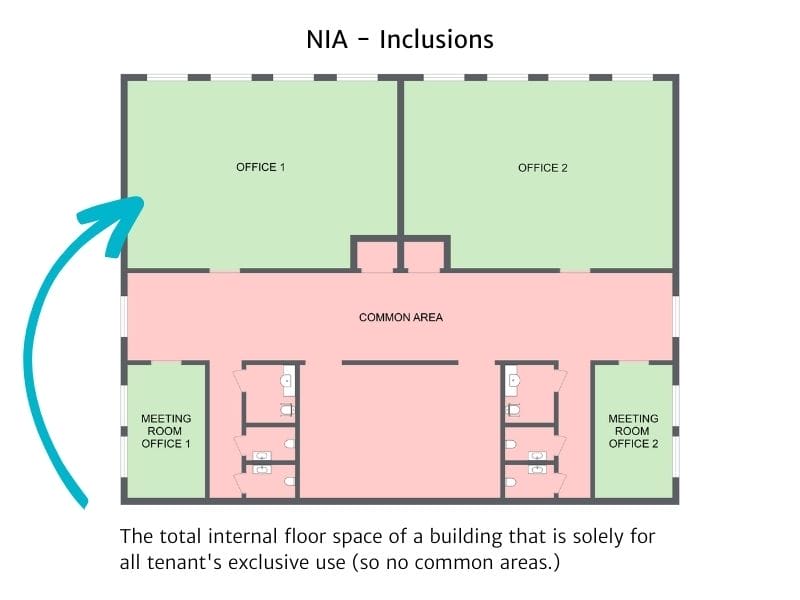
Net Internal Area Exclusions
NIA calculations exclude common areas (also called balance areas) because they are not considered specific to a particular occupant. Examples include:
- Shared entrance halls, lobbies, atriums, and landing areas.
- Shared restrooms, toilets, bathrooms, and janitorial rooms that store supplies and equipment used to maintain common areas in a building.
- Lifts or elevators that more than one occupant uses.
- Internal structural walls that separate tenants.
- Any areas controlled by external authorities such as utility companies.
- Spaces that are taken up with heating and cooling equipment, etc., if the equipment makes the rest of the space unusable.
- Any room or area with a ceiling height lower than 1.5m (5ft).
Top RoomSketcher Tip
"Because standards vary slightly worldwide, check with your local authorities for a complete list of the standard exclusions in your area."

NIA Compared: How It Differs from Other Measurement Standards
Let's take a look at the differences between Net Internal Area (NIA) and other calculations. For additional information on measurement standards, see GIA Explained, The Ultimate Guide to Understanding Property Size, and What is Gross Living Area, and How do you Calculate it?

Net Internal Area (NIA) vs. Gross Floor Area (GFA)
The Gross Floor Area (GFA) is generally defined as the total area of the building. GFA includes external walls and all areas inside the structure, including entrance lobbies and other common areas, lifts/elevators, stairwells, mechanical equipment areas, corridors, etc. In contrast, NIA does not include external or internal walls or common areas.
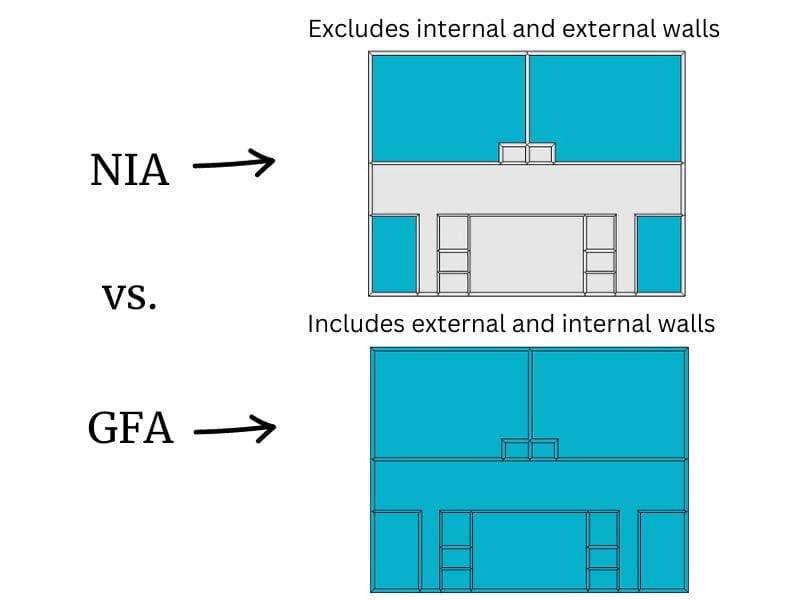
Net Internal Area (NIA) vs. Gross Internal Area (GIA)
GIA (also known as Gross Internal Floor Area) includes everything measured from inside the external walls, including internal walls and common areas in a building. In contrast, NIA does not include the internal walls and common areas.
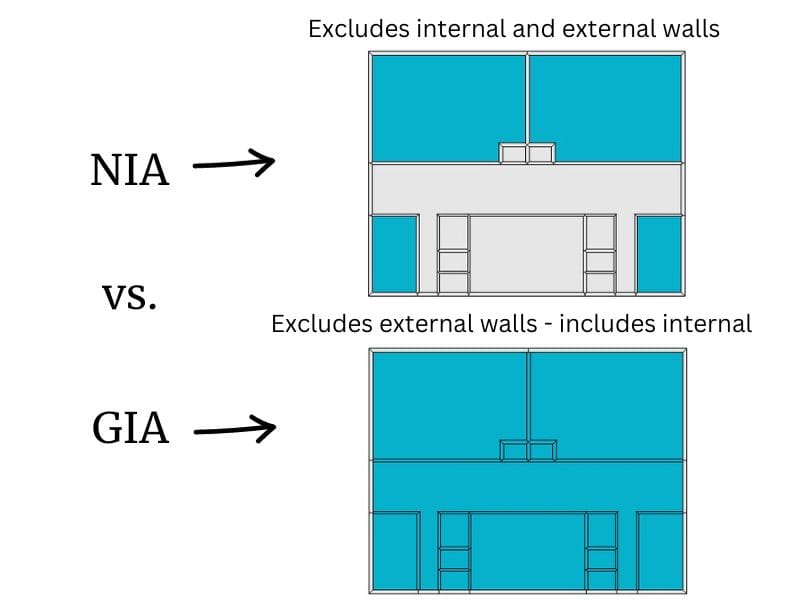
Net Internal Area (NIA) vs. Gross Living Area (GLA)
Gross Living Area (GLA) is used for residential rather than commercial properties. As such, the measurements are not related. To learn more about GLA, see What is Gross Living Area, and How do you Calculate it?
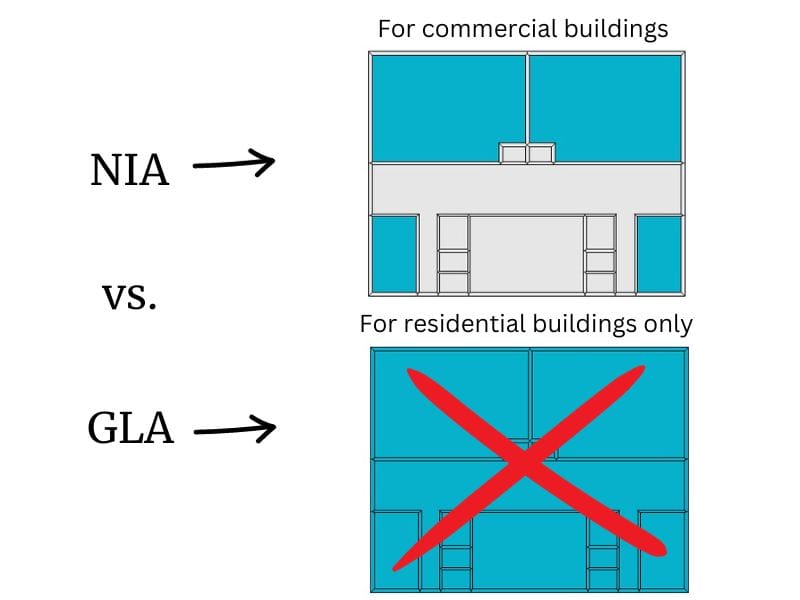
Net Internal Area (NIA) vs. Gross Building Area (GBA)
Net Internal Area describes the amount of usable space within a building and does not include external walls, internal walls, or common spaces. In contrast, Gross Building Area describes the total area of a building and includes common areas as well as internal and external walls.
GBA is similar to Gross Floor Area (GFA) in the commercial world.
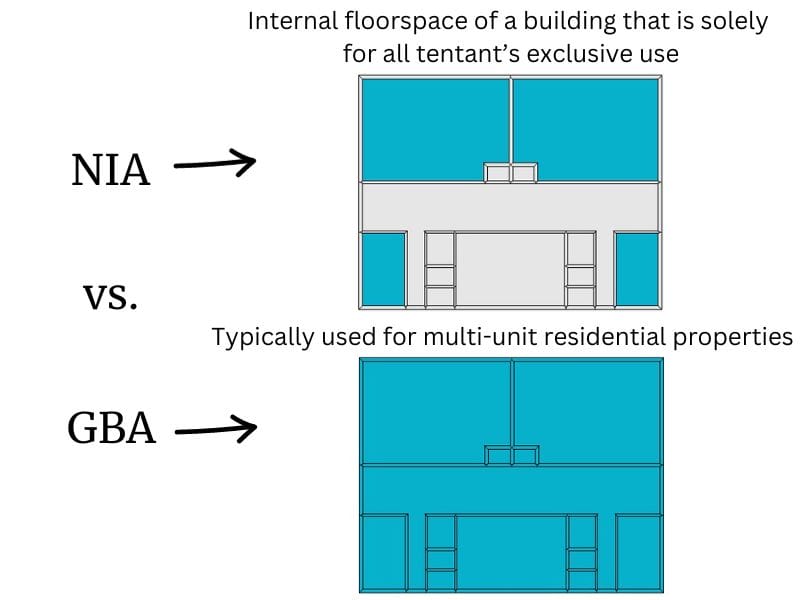
The Importance of Accurate NIA Calculation
The Net Internal Area is important for various purposes:
- Rentable Area: In commercial leases, rent is often based on the NIA, and tenants are charged based on the usable space they will occupy or use, plus a percentage of the common areas.
- Space Planning: For tenants and architects, NIA helps in space planning and designing the layout of offices, meeting rooms, and other functional spaces.
- Comparisons: NIA provides a standardized metric for comparing different properties. When evaluating potential spaces, tenants and landlords can use NIA to compare the cost and efficiency of space.
- Lease Negotiations: NIA is a key factor in lease negotiations. Understanding the NIA allows tenants and landlords to negotiate lease terms, including rent, maintenance costs, and other charges based on the usable space.
- Building Efficiency: Landlords and property managers use NIA to assess the efficiency of a building's layout and to make improvements that maximize the usable space.
Thus, NIA must be measured correctly and using the agreed-upon standards in your area.
Frequently Asked Questions About NIA
Stairs and ramps are included in the NIA if they are within the exclusive usable space of a single company/tenant. Shared stairways and ramps (used by multiple lessees) are excluded from the NIA measurement.
Some leases use the Gross Lease Area as a basis for rent calculations. A client’s Gross Leasable Area often includes:
- Their usable area or NIA.
- The space occupied by any external walls adjacent to their area. For example, a glass shopfront or a plain wall.
- The space occupied by their ½ of any shared internal walls or party walls.
- A pro-rata share of the common area. For example, if a tenant will occupy ⅓ of the usable space, their Gross Leasable Area calculation would include ⅓ of the common area space.
If a building is occupied by a single tenant, then the GLA is the same as the GFA.
Some leases use the Net Leaseable Area (NLA) as a basis for rent calculations. A client's Net Leasable Area or Net Leasable Area is usually defined as their usable area (or portion of the NIA) inside a building. Tenants may then pay an additional pro-rata fee for maintenance and the use of the common space.
Making NIA Measurements Easy and Accurate
In summary, Net Internal Area is an important metric in commercial real estate that helps determine the actual usable space within a building. It plays a role in lease agreements, space planning, and overall efficiency assessments for both landlords and tenants. It is one of several standard measurements used in commercial real estate.
To accurately calculate NIA, you can measure up the usable space in a building or use Floor Plan Software, like RoomSketcher, to improve the process of measuring NIA.
Don't forget to share this post!
Recommended Reads
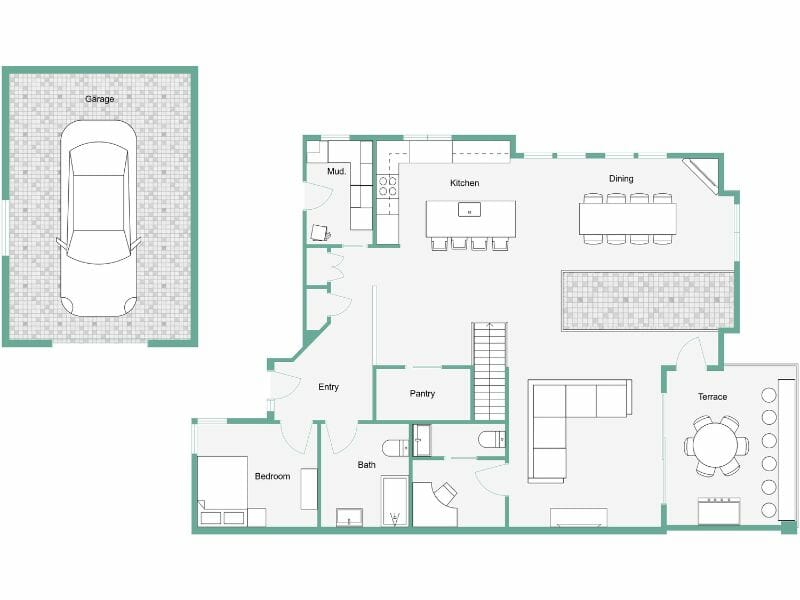
What is Gross Living Area (GLA) and How Do You Calculate It?
Learn what Gross Living Area (GLA) means, why it's important, and how to accurately calculate it for a property. Discover our expert guide.
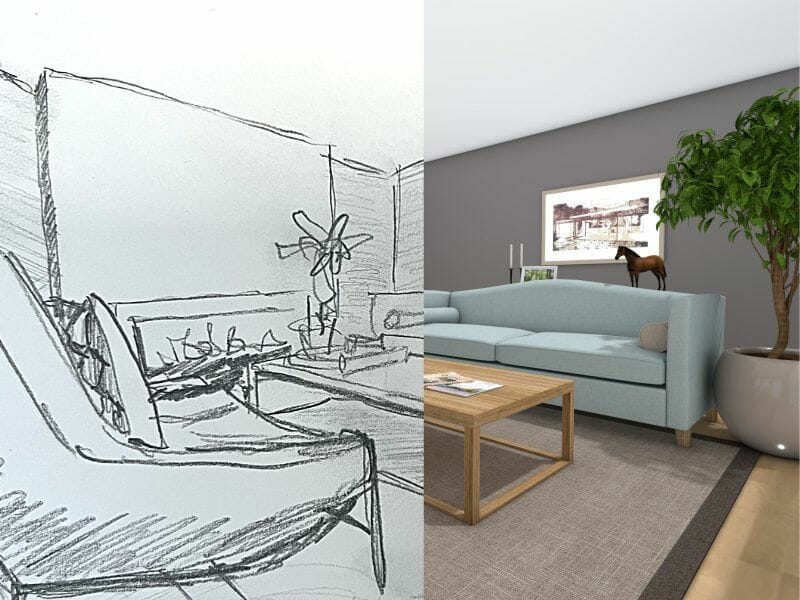
Interior Design Sketches vs. Computer Software
Since the dawn of interior design, visualization tools have been indispensable in breathing life into creative visions. From the earliest civilizations, where design ideas were etched on stone tablets, to the Renaissance era's intricate paper sketches and today’s advanced digital simulations, the tools of the trade have witnessed a transformative journey.
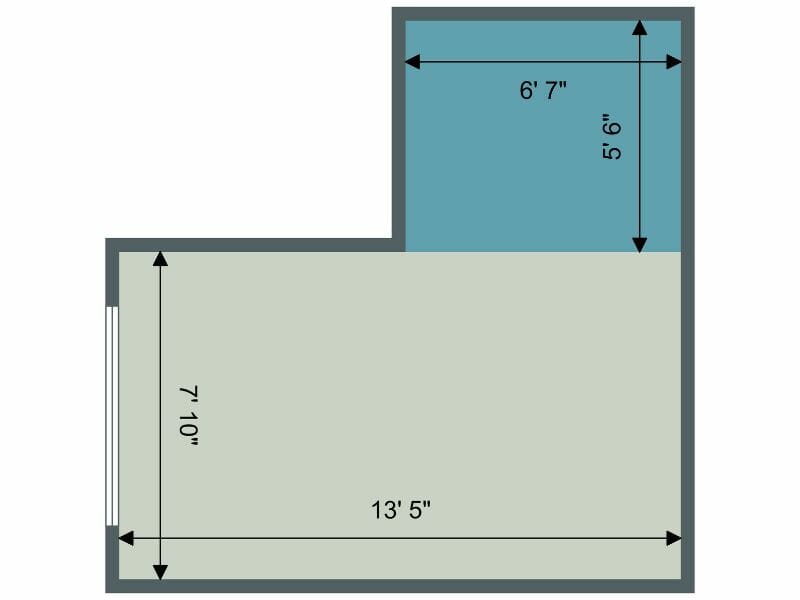
How to Measure Floor Area and Calculate Square Footage
Measure floor areas easily, quickly, and accurately. The correct results are essential for ordering materials for renovation projects, preparing sales and marketing materials for a property, and designing the furniture layout.
